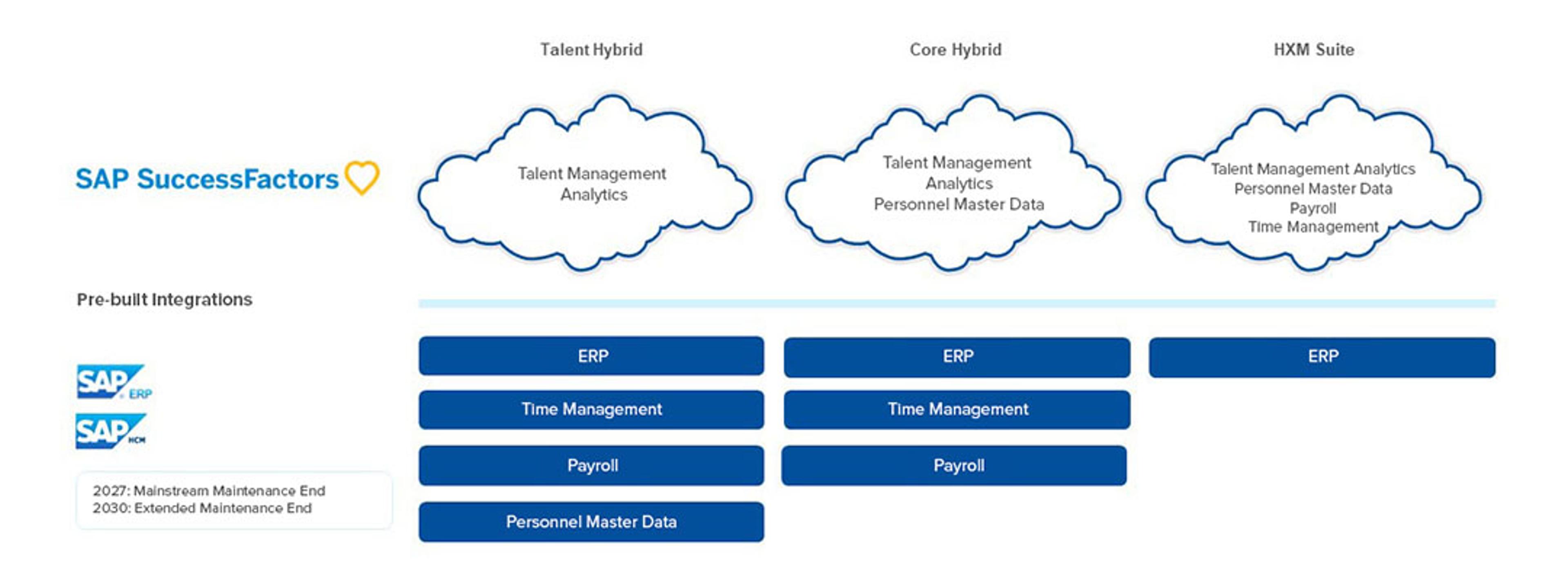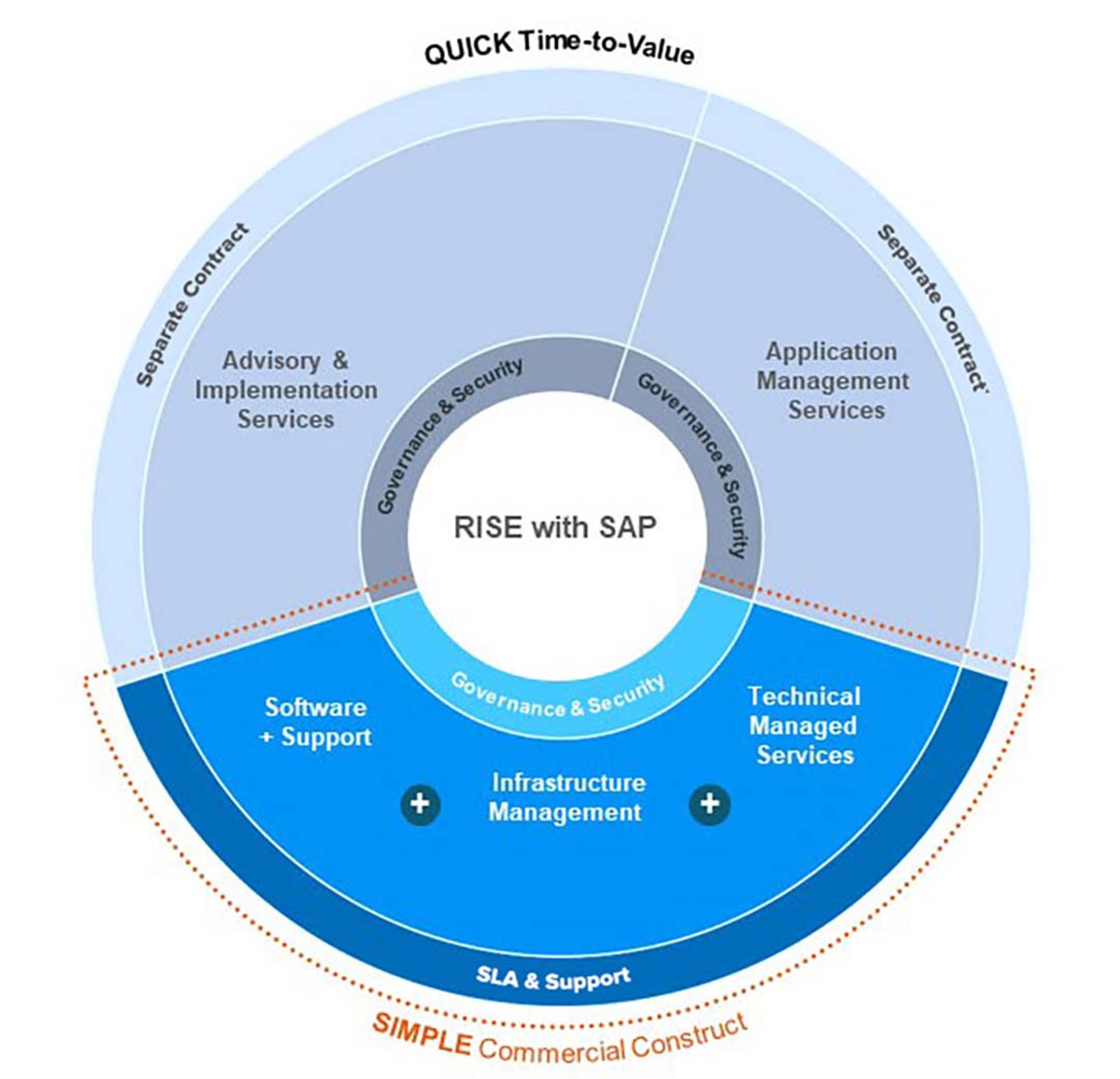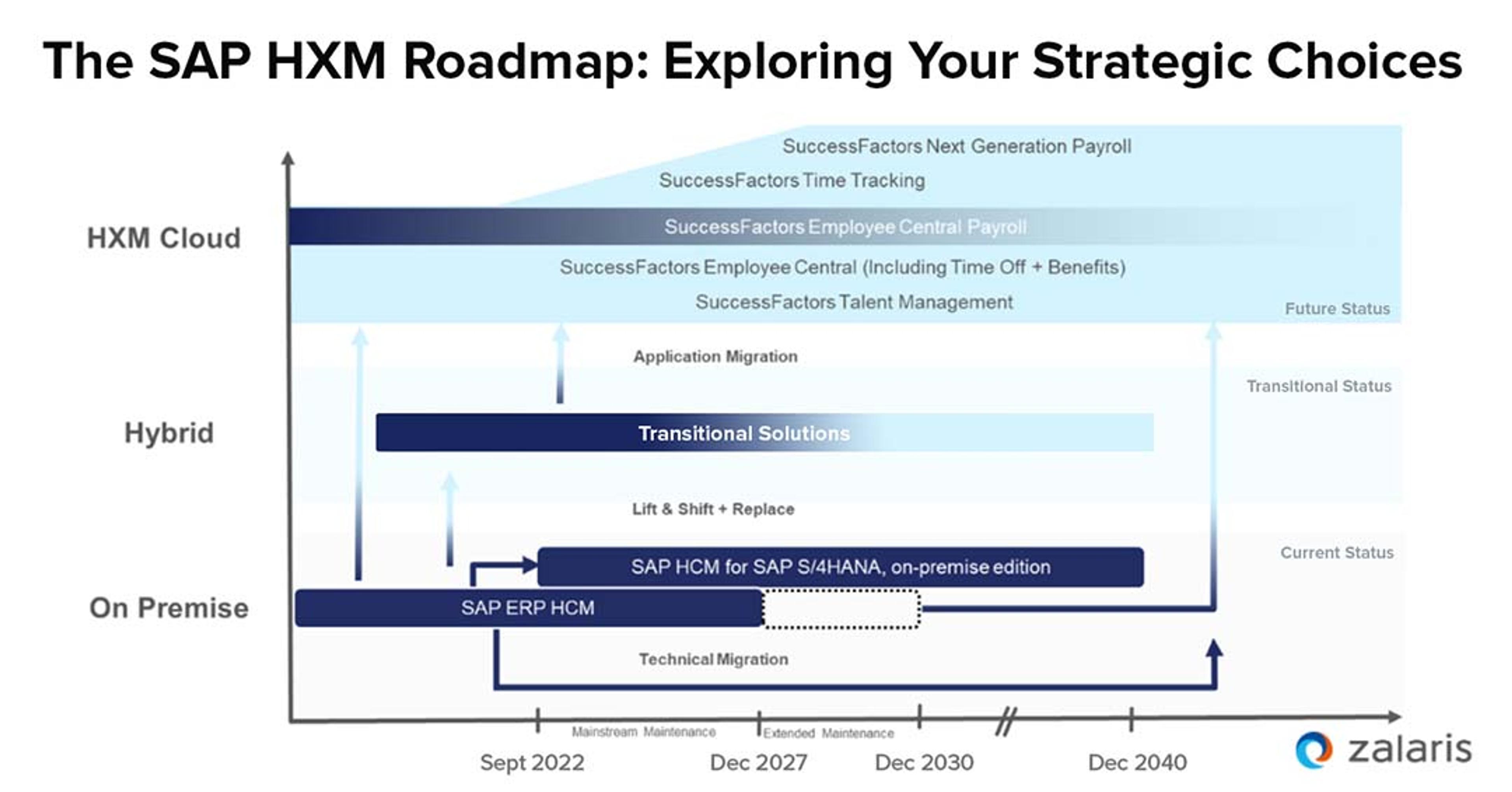SAP HXM Strategies – HXM Move, Rise with SAP, and Alternatives
The maintenance end for SAP HCM is dated for 2030. It's high time you looked at the SAP HR Roadmap and weighed the various paths for modernising your systems.
Zalaris

This blog dives into the nuances of HXM Move, Rise with SAP, and alternative strategies, empowering organisations to make informed decisions in reshaping their human resources, employee engagement, and talent management practices. Join us as we explore the pathways that not only signify technical progress but also strategic realignment in SAP solutions.
SAP HXM Strategies – HXM Move, Rise with SAP, & Alternatives
- HXM Move: Gradual transition to the cloud
- Technical and contractual details
- Our offers for system transition
- Rise with SAP – Transformation of your entire business suite
- Transition to S/4HANA
- Integration offers for HXM
- SAP decision tree
- Zalaris Cloud as an alternative
- Decide on an SAP HXM strategy now!
HXM Move: Gradual transition to the cloud
HXM Move, a proven concept by SAP with a new title, aims to raise awareness among existing customers about the benefits of the SAP SuccessFactors HXM Suite. This approach offers companies that have been using HCM as an integrated or standalone system a gradual transition to the cloud. Unlike the traditional HCM vision, HXM Move focuses on employees as individuals, recognising them as the most valuable asset.
By incorporating workforce signals and measuring employee satisfaction, HXM Move not only facilitates technical adjustments but also enhances the working atmosphere. Transitioning to HXM Move promises even better service, contributing to increased motivation and productivity while preventing the attrition of dissatisfied professionals.

Technical and contractual details
The initial draft for SAP SuccessFactors omitted many features of the previous on-premise solutions. However, SAP is in constant dialogue with users, leading to significant adjustments. Particularly in the Core HR domain, the provider has added many features. The system now allows for organisational representation and maintenance of master data. SAP has also incorporated the visualisation of knowledge processes.
The provider has transferred Time Management to the HXM Suite, making it more convenient through the cloud solution. Employees can easily log in and out via a browser, with a suitable interface available for mobile devices. Significant improvements are also expected in payroll functions, although these are in the pilot project stage. Another crucial technical aspect is the enhanced interface between your on-premise solutions and the cloud.
From a contractual perspective, there are important changes as well. Instead of a one-time license, SAP now offers services as Software-as-a-Service (SaaS). This brings several advantages for companies, including no need for IT infrastructure investments and relief from the burden of maintaining specialised personnel, addressing the shortage of skilled workers in this field.
Our offers for system transition
If you aim to shape the HXM future with this offering, we are here to assist you. We first assess your existing infrastructure, determining which offers make sense for you. We provide detailed advice on the pros and cons of various options, allowing you to decide where migration is sensible. You can choose from three alternatives:
- Talent Hybrid: Continue using your HCM on-premise while supplementing it with individual talent modules from the cloud, such as recruiting or learning services.
- Core Hybrid: Migrate master data to the cloud, utilising Employee Central in the SuccessFactors system, while certain subsystems, like time management and payroll, remain on-premise.
- HXM Suite Completely in the Cloud: Shift all HR functions to the cloud, including talent management, time management, and payroll, integrating them into the existing ERP system for other tasks.

Based on this, we collaboratively create an individual SAP HXM strategy tailored to your company’s requirements, considering the announced maintenance end for 2027 to take timely measures and ensure a smooth transition.
Rise with SAP – Transformation of your entire business suite
Another program SAP has introduced for customers is Rise with SAP. In contrast to HXM Move, this program is not solely focused on the HR domain but on the entire business suite. The goal is to transition the entire systems to the new S4/HANA technology, rather than migrating to the SAP SuccessFactors HXM Suite.

Transition to S/4HANA
As previously mentioned regarding the end of support for SAP HCM, a technology transition is required by 2027 at the latest. S/4HANA has been presented as the successor technology. With Rise with SAP, the provider aims to guide you through this process, offering new possibilities and providing complete infrastructure upon request.
Three implementation options
When transitioning your system to S/4HANA, you have three different packages to choose from. It is crucial to carefully examine which one is right for you:
- On-Premise Installation: Transfer your entire system to S/4HANA, preserving all individual functions. This is particularly relevant for users with extensive customisations, maintaining full control but requiring self-maintenance and infrastructure management.
- Private Cloud Setup: SAP takes over complete support for infrastructure and other services, suitable for customers with limited maintenance personnel. Individual settings and enhancements can still be maintained.
- Public Cloud Migration: Transfer your systems to the public cloud, sacrificing some customisation possibilities but benefiting from fully outsourced service.
Integration offers for HXM
While using S/4HANA primarily involves a technical transition, the Rise with SAP program also allows for integration with HXM. SAP has curated various packages for this purpose, incorporating different services from the SuccessFactors HXM Suite. The basic package, “Structures for Success,” includes SuccessFactors Employee Central and SAP Workzone for HR.
The second option, “Rethinking for Innovation,” adds services for training and competence building, such as SuccessFactors Learning and SAP Content Stream. The third solution, labeled “Transformation of Operational Processes,” focuses on optimising operational processes, including SuccessFactor EC Payroll alongside the services from Package 1.
1. Select the target system for transition:
To illustrate the various alternatives, it’s logical to view them along a timeline, with the existing SAP HCM serving as the reference point. However, this system is typically viable only until 2027, with extended support exceptions possible until 2030. Hence, it’s imperative to choose an alternative within this timeframe.
Two distinct paths lie ahead:
- Opting to transition your system to S/4HANA presents a viable choice. This system employs advanced technology while still allowing on-premise utilisation. Consequently, the adjustments required are relatively minimal. SAP has committed to supporting this transition until at least 2040, making it a long-term alternative.
- Beyond the on-premise option, additional avenues exist. For instance, you can deploy S/4HANA in a private or public cloud. Another enduring solution is the HXM Cloud. This alternative not only ensures simplicity in use and management but also opens up numerous possibilities for enhancing employee relations

2. Choose the path for implementation:
There are not only different target systems but also various paths to reach them. Especially when opting to use the HXM Cloud in the long term, there are different options. One approach is to transition directly to this system. However, it’s crucial to note that this system is still under development.
Features like SuccessFactors Time Tracking are currently being added, and the SuccessFactors Next Generation Payroll is not yet available in Germany. It will likely take some time before you can utilise this function. Therefore, this step is only feasible if you require functions that are already available.
The second alternative involves initially implementing a hybrid system. This means using some cloud services while still relying on existing systems for functions not yet available. Setting up an S/4HANA Private Cloud is also a possibility.
Another option is to simply wait. There are still several years until 2027. During this time, the offerings for the HXM Cloud can continue to expand. You can make the transition when the required functions are available, reducing risks. However, it’s essential to recognise that, at that point, you’ll have a limited timeframe for the transition. Hence, even in this scenario, careful strategic planning is necessary from now.
SAP decision tree
The right strategy for your future in HXM depends on various factors. Firstly, the systems you’ve been using play a crucial role. Additionally, you must decide how you envision the future of personnel management in your company. If you are content with purely operational processing, sticking with HCM is an option. However, if you want to prioritise people, transitioning to HXM is recommended.
To connect these diverse prerequisites, SAP has designed a decision tree. This allows you to precisely choose the combination that aligns with your company. Based on these criteria, SAP then recommends a suitable solution. The decision is relatively straightforward for new customers, as starting with the cloud from the beginning sets a course for a future-oriented system.
For existing SAP users, the next question arises regarding the use of Employee Central. However, in many companies, this is not yet the case. Subsequently, you need to consider whether you are interested in a fundamental redesign of your HR processes. If this resonates with you, the next step is to deliberate on whether you are willing to outsource infrastructure to the cloud. If so, SAP recommends implementing HXM elements alongside a private cloud. This decision path is common in many companies, yet several other possibilities exist. SAP has outlined six different options in this regard.
Moreover, each alternative comes with various implementation possibilities. The transition of individual services can occur immediately, or adjustments can be implemented gradually. All this underscores the necessity for intensive consultation and meticulous planning in this process. Therefore, it is advisable to engage with these aspects as early as possible. Delaying this decision could eliminate several implementation options, as the time for such choices may have already passed.
Zalaris Cloud as an alternative
Embarking on a transformative journey through the intricacies of SAP solutions, we present the Zalaris Cloud as a compelling alternative, offering a comprehensive Human Experience Management (HXM) solution.
Ideal for companies focusing on substantive issues, the Zalaris Cloud allows you to offload administrative tasks, enabling employees to engage in meaningful activities contributing to your company’s development.
The Zalaris Cloud offers high flexibility, allowing you to tailor services to your specific requirements – whether outsourcing individual applications or entrusting us with entire processes.
Decide on an SAP HXM strategy now!
Exciting times lie ahead for SAP users! The software company has developed an entirely new system, not only distinguished by its use of the cloud but also by placing individuals at the center through HXM. This approach can enhance employee satisfaction, leading to increased motivation and reduced turnover. Moreover, SAP has already announced the end of support for HCM On-Premise, making system transitions unavoidable.
However, there are various paths available for implementing these changes, necessitating a detailed analysis of your existing systems and a clear goal definition. Through careful consideration, you can find a new system that perfectly aligns with your company’s needs and we at Zalaris look forward to accompanying you on this journey as a trusted companion. Get in touch with our experts today.

Zalaris
Author
Table of Contents
- SAP HXM Strategies – HXM Move, Rise with SAP, & Alternatives
- HXM Move: Gradual transition to the cloud
- Technical and contractual details
- Our offers for system transition
- Rise with SAP – Transformation of your entire business suite
- Transition to S/4HANA
- Integration offers for HXM
- SAP decision tree
- Zalaris Cloud as an alternative
- Decide on an SAP HXM strategy now!